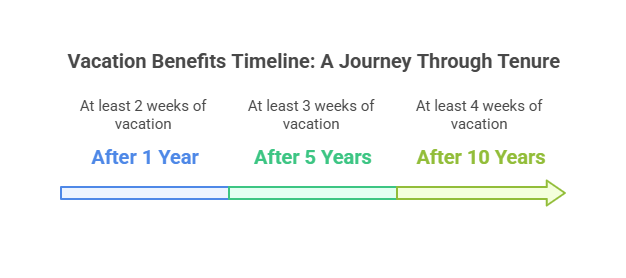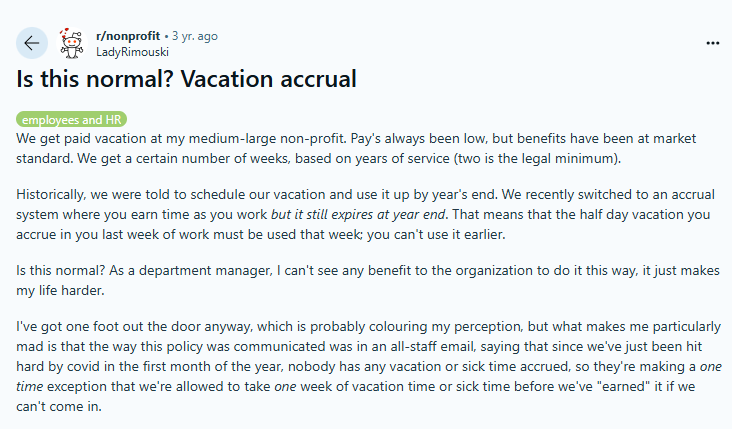Vacation Accrued: Benefits for Employers & Employees

At One Accounting, we understand that managing time off is an essential aspect of fostering a healthy and productive workplace.
Vacation accrual is a system that not only ensures employees have the flexibility to take well-deserved breaks but also provides employers with a structured approach to managing leave balances. This method benefits both parties by promoting work-life balance, improving employee satisfaction, and streamlining payroll processes.
What is Vacation Accrual?
Accrued vacation pay is the vacation time an employee has earned. This is based on the company’s employee benefits policy. However, the employee has not yet used or been paid for this time.
Vacation accrual is a way to earn paid time off from work. It is like a bank account for your vacation days. Instead of getting all your vacation days at once, you earn them gradually.
You earn a little bit of vacation time each time you get paid. This system is used by many companies. See how the Ontario minimum wage increase impacts employee rights and benefits.
The vacation time you earn is called vacation accrued. You can use your vacation accrued for many things. You can use it to go on a trip.
You can use it to relax at home. You can also use it if you get sick. Vacation accrual helps you plan your time off. It also helps your employer keep track of your time off.
For example, an employee could get 8 hours of paid time off every 2 weeks.
Now that vacation accrual has been explained, let’s explore how it aligns with Canadian regulations and guidelines.
Canadian regulations and guidelines
The federal law governing employee vacations bound employers in Canada.
An employee has the right to certain benefits after working for you for a full year. This can be a full calendar year or one year from their hire date
- At least 2 weeks of vacation after completing one year of work
- At least 3 weeks of vacation after completing five years of work
- At least 4 weeks of vacation after completing 10 years of work

“The longer an employee stays in the same job, the more vacation time they’ll have earned.”
All provinces in Canada comply with the federal government’s minimum two-week vacation entitlement. Except Saskatchewan, where workers are entitled to at least three weeks of paid vacation.
The impact of vacation accrual extends far beyond individual employees, offering significant advantages to employers as well.
Benefits for Employers
Implementing vacation accrual policies offers significant advantages for employers, beyond simply adhering to labor regulations such as,
- Companies may encourage a more focused and energized workforce by encouraging workers to use their accumulated vacation time.
- Businesses can avoid large payments when workers take time off or leave. They can do this by tracking vacation pay as it comes in.
- Employers can minimize the possibility of fines and employee complaints by implementing a vacation accrual system.
Benefits for Employees
Vacation accrual systems provide employees with a fair and transparent way to earn and plan time off, offering a sense of security and work-life balance. Other benefits include,
- Better mental and physical health can result from their ability to relax spend time with loved ones, or engage in personal hobbies.
- Employee morale and employer trust may both rise as a result of this transparency.
- Employees who have accrued vacation pay have financial security during their time off.
- Longer, more fulfilling careers may be influenced by their ability to collect and use vacation time.
People often use the terms “vacation accrual” and “PTO” interchangeably, but they’re not always the same thing. Let’s clarify the difference.

Speaking of vacation accrual, this is a conversation on Reddit, and it’s a common topic people question
Understanding the differences between vacation accrual systems and paid time off (PTO) policies is essential for both employers and employees to determine which approach best aligns with their needs and organizational goals. Let’s look into the differences.
Vacation Accrued Vs. Paid Vacation (PTO)
Vacation accrual and paid time off (PTO) are both ways to get time off from work. They both let you take paid breaks. But they are not the same thing.
It’s important to know the difference. This can help you plan your time off. It can also help you understand your rights as an employee.
Paid time off (PTO) is a bit different. PTO often includes all kinds of time off. This can include vacation time. It can also include sick time. It might include time for appointments or family leave.
Some companies give you all your PTO at the start of the year. This is like having a full bucket on day one. You can use this time in any way you need. Understand how changes like Ontario’s minimum wage increase can impact PTO policies.
Understanding vacation accrual is essential, but how do you manage it effectively? Let’s explore how to improve employee satisfaction with robust vacation tracking.
Improve Employee Satisfaction with Effective Vacation Tracking
Keeping track of employee vacation time can be tricky. But it’s really important for happy employees. A good system makes things clear and fair for everyone. This article will show you how to track vacation time the right way.
Tracking vacation time well is important. It shows you care about your employees. It helps avoid problems. It makes your company a better place to work.
Let’s explore why vacation tracking is important and what are the problems with poor vacation tracking.
Why is Vacation Tracking Important?
Employees need to know how much time off they have. They need to plan their vacations and life events. A clear system helps them do this. When you track vacation time well, it shows you care about your employees.
Problems with Poor Vacation Tracking
If you don’t track vacation time well, problems happen. Employees might not get the time off they earned. Mistakes can happen. This can make employees upset and lose trust.
Tips for Accurate Tracking
- Keep good records. Write down every time an employee takes time off.
- Update the records often. Don’t wait until the end of the year.
- Use a system everyone understands. Make it easy for employees to check their time off.
- Train your managers. They need to know the system too.
- Talk to your employees. Ask them if the system works for them.
Conclusion
Vacation accrual is a really good system for everyone. It helps employees and it helps employers. Employees get time off to relax and come back to work feeling good. Employers get workers who are happier and do better work.
It’s important to understand how vacation accrual works. It’s good to know the rules and how to keep track of time off. When everyone understands the system, things go smoothly.
A good vacation accrual system makes payroll easier. It tracks earned and used vacation time accurately. This helps follow labor laws and cuts down on mistakes.
If you need any support from accountants, please contact One Accounting. Our team of professionals can guide you through audits, tax filings, and financial documentation to ensure you’re fully prepared.
Vacation accrual is a win-win. It makes the workplace better and helps everyone succeed. So, take your vacation time! You’ve earned it.
Frequently Asked Questions
Vacation accrual provides employees with a set amount of paid time off they earn over time, while unlimited vacation policies allow employees to take as much leave as they need, typically without specific limits or accrual.
Yes, part-time employees can accrue vacation time based on the number of hours they work, although the rate of accrual may differ from full-time employees depending on company policies.
Most payroll systems have built-in features to automatically calculate and track accrued vacation time, ensuring accurate balances based on hours worked or tenure.
This depends on local labor laws and company policies. In many jurisdictions, employers must pay out unused vacation accrual upon termination. However, some policies may restrict payouts if employees fail to meet specific conditions.
Yes, vacation payouts are considered taxable income for employees and must be reported accordingly. Employers are also required to withhold applicable taxes, such as federal income tax, Social Security, and Medicare.
Small businesses can start with a simple, clear policy that aligns with local labor laws, using tools like employee handbooks and basic payroll software to manage vacation accrual efficiently.
Vacation accrual ensures employees have guaranteed paid time off to rest and recharge, reducing stress and promoting better mental health and work-life balance.
In some regions, employers are required to provide regular updates on vacation accrual balances. Even where it’s not mandated, keeping employees informed fosters transparency and trust.
